As the Danube River threatens Bratislava, city and regional officials have rushed to install barriers across several key boroughs, including Karlova Ves, Devín, Devínska Nová Ves, the Old Town, and Petržalka, in a race against time to protect the capital from flooding.
By late morning, it was reported that Tyršovo nábrežie, the promenade near the Eurovea shopping centre, and Fajnorovo nábrežie, had already been flooded. City and regional officials urged residents and visitors to avoid these areas.
The water level of the Danube has ceased rising significantly, reaching 956 cm in the Old Town and 900 cm in Devín at 23:30.
“The peak of the ongoing flood wave is currently occurring in Devín and Bratislava,” the Slovak Hydrometeorological Institute (SHMÚ) said on Monday night, adding that the water level has stopped rising. “Considering the situation in Lower Austria and the Morava River, stability at current water levels, with some fluctuations, is expected in the coming hours.”
The river is expected to crest in downtown Bratislava between Monday night and Tuesday morning.
The map below highlights the Morava River:
“The worst is not yet behind us,” Prime Minister Robert Fico said on Monday evening , adding that small streams, in particular, remain to be the problem. “The damage is significant but manageable.”
Fico, who turned 60 last Sunday and spent weeks attacking his political opponent Michal Šimečka, has been unusually quiet about the recent floods in Slovakia. This contrasts sharply with the responses of his counterparts in Czechia and Poland. What Fico, who survived an assassination attempt in mid-May, has been doing over the past few days remains unknown.
Flood warnings remain in effect in a number of districts in western and eastern Slovakia.
While city crews are working to clear fallen trees and branches, and repair the overhead lines, authorities continue to advise people to stay away from forests and parks in and around the capital. In the Old Town, three parks have been temporarily closed: Medická, Grassalkovich, and Slubekova gardens.
Bratislava, like much of Slovakia, remained under rainfall warnings until 18:00 on Monday. At present, Bratislava and the surrounding districts of Senec, Malacky, and Pezinok are under a fog warning until Tuesday morning.
Devín borough cut off
The weather has been disrupting public transport in some areas, particularly on routes to the Devín and Devínska Nová Ves boroughs.
Bratislava public transport restrictions on September 16
Since the start of daily operations, service on Tram 9 has been suspended in both directions on Miletičova and Ružinovská streets. Tram 9 is running from the Trnavské mýto (B) stop to Nové Mesto station and back to Kútiky. Replacement bus service X9 is operating in both directions between the Trnavské mýto (J) and Astronomická stops.
Bus 29 is running from the Malá scéna stop to the Botanical Garden, continuing through Karlova Ves, Dúbravka, Vápenka, Eisnerova, and from the Uhrovecká stop on its route to Opletalova, VW5, and back along the same detoured route. It does not serve the Riviéra (I, P) to Pri Sandbergu (A, D), nor Mlynská (A, B) stops.
Buses 20, 21, and 29 do not serve the Mlynská (A, B) stop.
Bus 43 operates in both directions between Patrónka and Železná studnička.
Source: DPB
The road from Devínska Nová Ves, where evacuation has begun on several streets, to Devín, has been completely closed.
“The road will be accessible only to emergency services,” the Devínska Nová Ves Borough Hall announced on social media.
Meanwhile, the borough has informed residents that Bus 29 will operate up to the Pri Sandbergu (Na hriadkach) stop, where passengers will need to walk to the Sandberg parking lot and transfer to a military vehicle, which will transport them to the centre of Devín, near the church and the cultural house.
“The same arrangement applies for the return journey from Devín – a military vehicle will wait at the church to transport passengers to the edge of the embankment near Devínska Nová Ves, where they will transfer to a bus,” the Devín borough said.
Water is likely to isolate Devín for approximately 20 hours, announced Bratislava Region Governor Juraj Droba on Monday. Supplies for residents are ensured, the governor added.
He also noted that cycling bridges over the Morava River are closed.
Roads to avoid
Istrijská Street in Devínska Nová Ves is proving difficult to navigate, and authorities are advising against using it. Additionally, Devínska cesta (road) is impassable between the exit to Dlhé Diely and Devín due to a landslide and flooding.
Slovanské nábrežie (embankment), Kremeľská Street, and Devínske jazero (lake) in Devín are also flooded. In Petržalka, another borough of Bratislava, Viedenská cesta (road) is closed from the exhibition grounds to the section under the Old Bridge (Starý most), as well as Pri Seči Street from the filling station, and Kočánkova Street up to the Old Bridge.
In the Trnava Region, which borders the Bratislava Region, the Medveďov border crossing towards Győr, Hungary, is closed until further notice. The bridge at the Lanžhot – Brodské border crossing is completely closed due to the rising water levels of the Morava River.
According to meteorologists, the precipitation activity is peaking not only in Slovakia, but also in the surrounding countries that have been affected. For the rest of the day, meteorologists still expect showers, but they do not anticipate any significant rainfall amounts in Slovakia.
Zoo closed, National Gallery closed
Bratislava Zoo will remain closed for an extended period due to damage caused by persistent rain over the weekend.
“The most important thing is that we have managed to save all the animals,” the zoo posted on social media.
However, it added that the revenue shortfall will be devastating for the zoo. As a result, a fundraising campaign has been launched.
The Slovak National Gallery will also remain closed on Tuesday and Wednesday due to the increased water level of the Danube. Bratislava Castle, which houses the History Museum, was closed on Monday. The museum is expected to reopen on Wednesday.
Some properties managed by the Bratislava Region are experiencing flooded basements, including several secondary schools.
“The affected locations include the grammar school on Skalická Street, the technical schools on Adlerová and Sklenárová Streets, the business academy on Račianska Street, the dormitory on Saratovská Street, and the grammar schools on Grösslingová and Pankúchová Streets,” Governor Droba said at a press conference on Monday.
All secondary school students in Bratislava are set to return to their classrooms on Tuesday. On Monday, multiple secondary schools across the Bratislava Region were shut due to adverse weather conditions. Several primary schools and kindergartens in various Bratislava boroughs, and other towns in the region, also opted to remain closed for the day.
Droba also mentioned critical seepage issues at the synagogue in the town of Senec, though this is limited to the new section. The original restored heritage site appears to be intact, the governor added. There is also a risk of water damage to Aréna Theatre, located on the Petržalka side of the Danube in Bratislava.
“We fear that if the water level exceeds 930 cm, significant damage could occur at Divadlo Aréna. Currently, emergency services are on site, sandbagging the entire perimeter of the building,” Droba said.
Streams the biggest problem
Still, the situation in Slovakia is gradually returning to normal. Bridges in Čadca, in northern Slovakia, where the situation was critical on September 15, are now open. According to Košice Mayor Jaroslav Polaček, the situation in Košice is calm.
“Here in Košice, despite the ongoing rain, we are truly fortunate. We are monitoring the watercourses, and civil protection is on alert,” the mayor told TASR on Monday.
The situation in western Slovakia also appears to be improving, with water levels in the streams gradually receding, according to the Slovak Hydrometeorological Institute.
However, SHMÚ reports that a challenging situation remains in the Morava River basin—particularly in the Záhorie region, where smaller tributaries from the Small Carpathians continue to contribute to rising water levels. The Morava River, which flows into the Danube in Devín, is still experiencing a slight increase at its upper reaches, with a more significant rise further downstream.
The situation with streams running across the villages below the Small Carpathians, including Malina and Rudava, has proven to be the biggest problem in recent days.
In the Malacky district of western Slovakia, a breach has occurred in the levee on the Malina stream. Jozef Moravčík, director of the Slovak Water Management Enterprise, assured that this area is uninhabited. In addition, due to adverse weather conditions, the road between Malé Leváre and Gajary in the Malacky district remains impassable.
The town of Komárno in southern Slovakia is bracing for the rising Danube. Mayor Béla Keszegh does not anticipate that the Danube will overflow into the town.
“The Danube may overflow, but it is not expected to cause major problems in Komárno,” he said. “While buildings in flood-prone areas of Komárno could be inundated, the town is protected by a flood barrier.”
Estimates suggest that the Danube in Komárno is expected to peak at around 840 centimetres.


 The Danube in Bratislava on September 16, 2024. (source: TASR)
The Danube in Bratislava on September 16, 2024. (source: TASR)
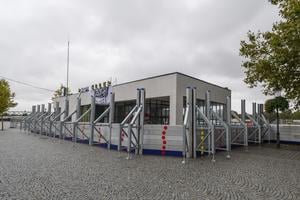
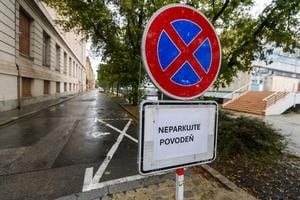
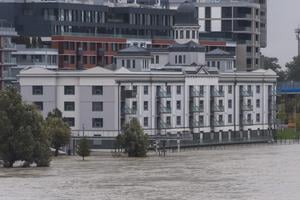
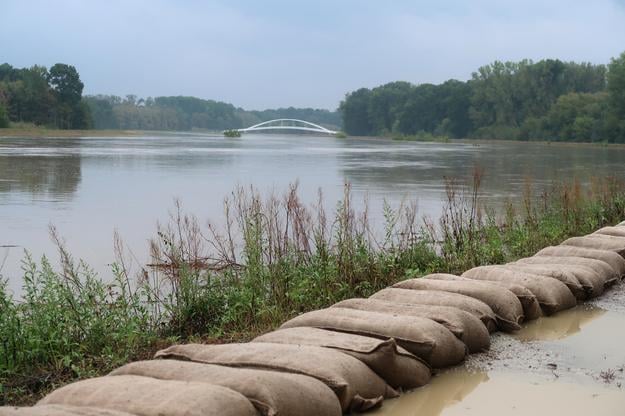 The water level of the Morava River exceeded six metres near Kopčany in the Skalica district on September 16, 2024. As recently as Friday, it had not even reached two metres. (source: TASR - Ondrej Hercegh )
The water level of the Morava River exceeded six metres near Kopčany in the Skalica district on September 16, 2024. As recently as Friday, it had not even reached two metres. (source: TASR - Ondrej Hercegh )
 Flood warnings in effect on the evening of September 16, 2024. (source: SHMÚ)
Flood warnings in effect on the evening of September 16, 2024. (source: SHMÚ)
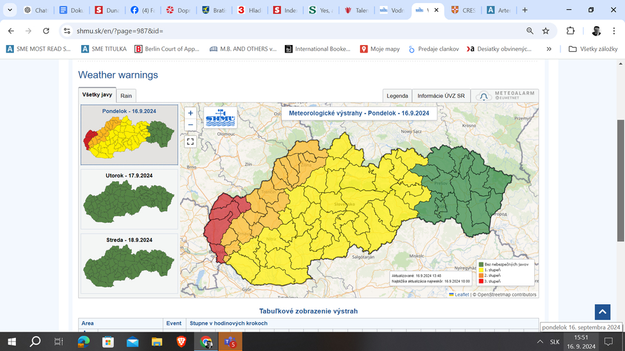 Weather warnings in Slovakia on September 16, 2024. (source: SHMÚ)
Weather warnings in Slovakia on September 16, 2024. (source: SHMÚ)
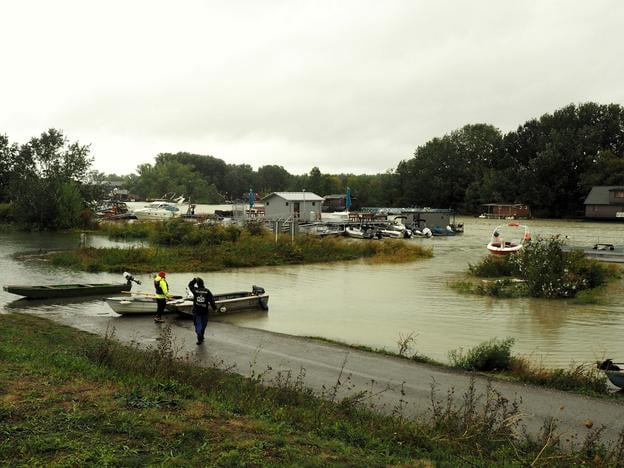 The Zuzana Bay arm in the Bratislava district of Petržalka on September 16, 2024. High water levels have submerged roads and footbridges leading to floating homes. (source: TASR - Miro Košírer)
The Zuzana Bay arm in the Bratislava district of Petržalka on September 16, 2024. High water levels have submerged roads and footbridges leading to floating homes. (source: TASR - Miro Košírer)
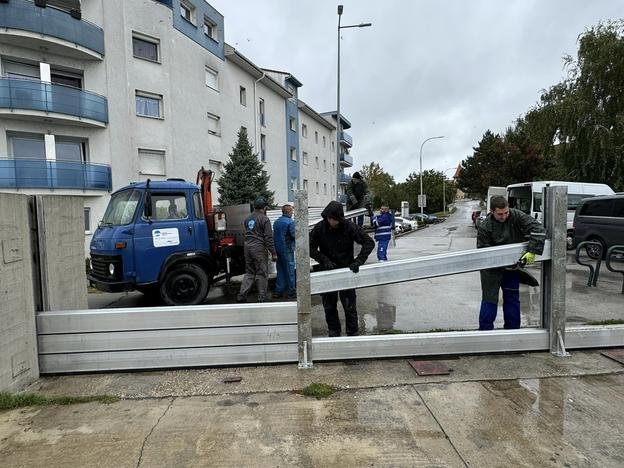 Preparations for the Danube's peaking in Komárno. (source: Facebook/Komárno)
Preparations for the Danube's peaking in Komárno. (source: Facebook/Komárno)
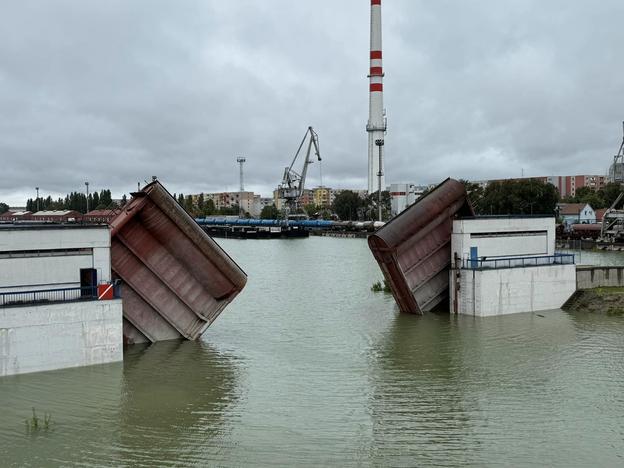 Preparations for the Danube's peak in Komárno on September 16, 2024. (source: Facebook/Komárno)
Preparations for the Danube's peak in Komárno on September 16, 2024. (source: Facebook/Komárno)